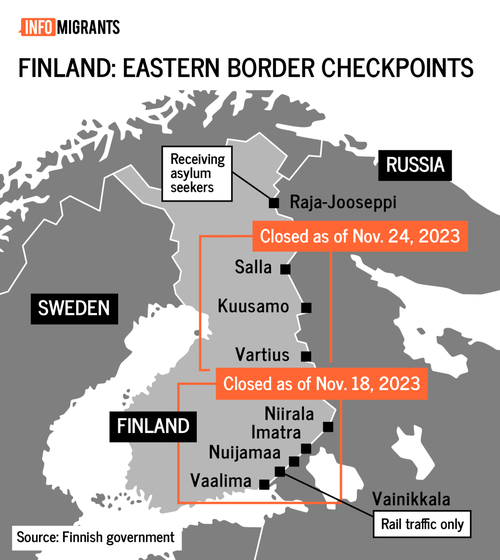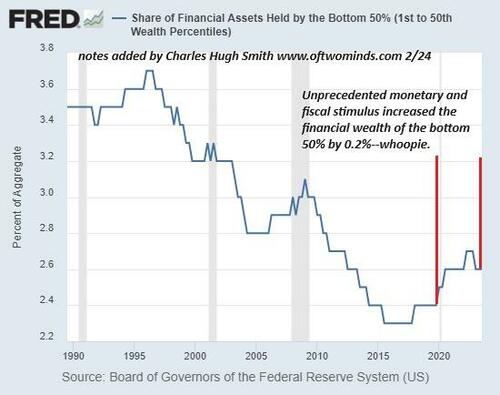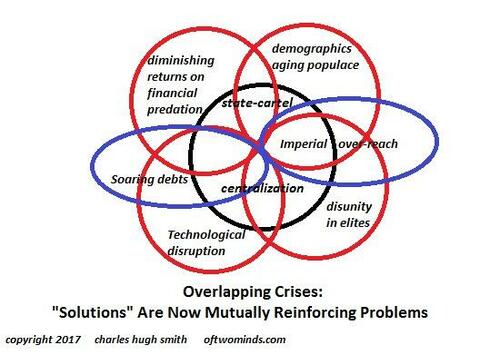Authored by Michael Tracey,
“Dangerous, diabolical, and dastardly” is how Hakeem Jeffries, the House Democratic Leader, just described the so-called “Project 2025” planning document that all liberals have now been commanded to light their hair on fire about and run around in circles screeching how it portends some imminent apocalyptic MAGA takeover.

First off, it’s the least surprising thing in the world that the preeminent DC think tank of the “Conservative Movement” would merge itself to the maximum extent possible with the branding and sensibility of Donald Trump, the current undisputed ruler of the “Conservative Movement,” such as it exists. What would be far more surprising is if the Heritage Foundation, which drafted the document now being wailed about by every Democratic pundit, had not maximally ingratiated itself with Trump — in fact, the Trump Administration’s embrace of the Heritage Foundation was already well underway during his first term. But now liberals, desperate for a campaign pivot amidst Joe Biden’s cognitive implosion, are using their usual overwrought melodrama to hype “Project 2025” as slam-dunk proof that Trump obviously represents an Existential Threat To American Democracy™ or whatever. What they curiously fail to mention is that the document is robustly aligned with many of the liberals’ most sacrosanct priorities.
Amusingly, Trump has been busy lately ‘disavowing’ Project 2025, but that’s neither here nor there.
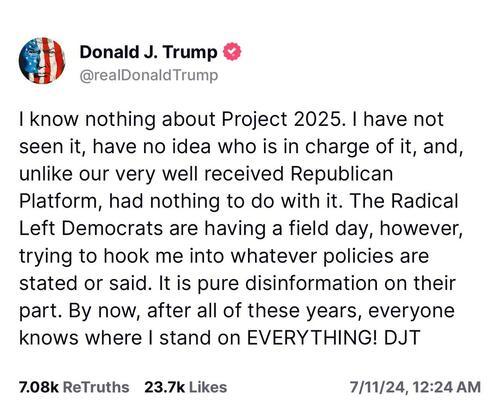
What percentage of despondent Dems who have this crippling fear of Project 2025 have actually read the document? I’m not going to claim to have read all 920 pages, but I did read the sections on the Department of Defense, State Department, and “Intelligence Community.” I would love to ask MSNBC anchors if they read these portions, because if they did, they should be celebrating the glorious reaffirmation of “bipartisan consensus” contained therein, rather than fulminating about some despotic nightmare.
Christopher C. Miller, who briefly served as Trump’s “acting” Secretary of Defense, writes in his Project 2025 contribution that the next Conservative Administration must “prevent Beijing’s hegemony over Asia,” including by “modernizing and expanding the US nuclear arsenal.” Because we all know that what the “Deep State” fears most is pouring untold billions into nuclear weapons boondoggles that will keep themselves and their corporate partners gainfully employed in perpetuity. Miller solemnly declares that in addition to China, “the United States and its allies also face real threats from Russia, as evidenced by Vladimir Putin’s brutal war in Ukraine, as well as from Iran, North Korea, and transnational terrorism.”
Countering these alleged threats, he concludes, “will require more spending on defense, both by the United States and by its allies.” Thus the fearsome Project 2025 envisions a future in which the march of US and “allied” militarization continues apace, just like it has during the Biden Administration. Someone’s going to have to explain how massively increasing expenditures on what is sometimes derisively referred to as the “military-industrial complex” represents any sort of severe blow to the “Deep State,” as the trembling libs claim to fear, and as “anti-establishment” right-wingers claim to yearn for.
Miller says US conventional force planning must be structured in such a manner as to “defeat a Chinese invasion of Taiwan,” so if what you deplore in this document is that bipartisan planning for war with China could accelerate under a second Trump Administration, that may be legitimate — but that does not seem to be what the liberals are whining about.
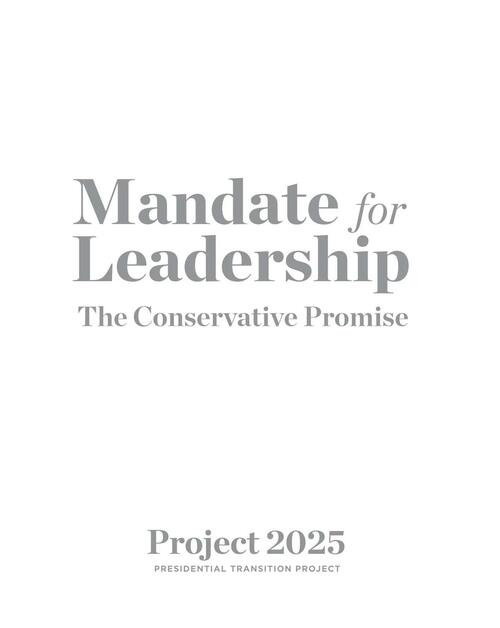
The chilling cover page of the Think Tank document
Because the Biden Administration is currently doing the same thing!
Miller amusingly calls for the “acquisition community,” also known as arms manufacturers, to be granted greater flexibility in securing multi-year procurement contracts to spur the “innovation” required for the Defense Industrial Sector to adequately confront all the scary Emerging Threats around the world. Liberals in a state of terror can take solace that this multi-year procurement reform has already been well underway during the Biden Administration, largely to provide armaments for Ukraine (and Taiwan), and these legislative adjustments have been enacted with thoroughly bipartisan support, as usual.
“Replenish and maintain US stockpiles of ammunition and other equipment that have been depleted as a result of US support to Ukraine,” the document advises. Good news: that, again, is already happening, with new artillery factories popping up everywhere from Arkansas to Texas.
Miller’s DOD section additionally declares that the US “must regain its role” as the “Arsenal of Democracy” by further ramping up foreign arms sales, which he says have fallen to unacceptable lows under the Biden Administration — despite Biden and Democrats similarly trumpeting the “Arsenal of Democracy” concept as it relates to Ukraine and other conflicts in which “Democracy is on the Line,” just like WWII. (Yawn.) Apparently there is firm agreement on this messianic imperative amongst the “Project 2025” crowd. The US has firmly retained its distinction as the world’s number one global arms exporter all throughout the Biden Administration, but this clearly isn’t enough for Project 2025. Weirdly, the MSNBC liberals don’t seem to be particularly troubled by that policy prescription.
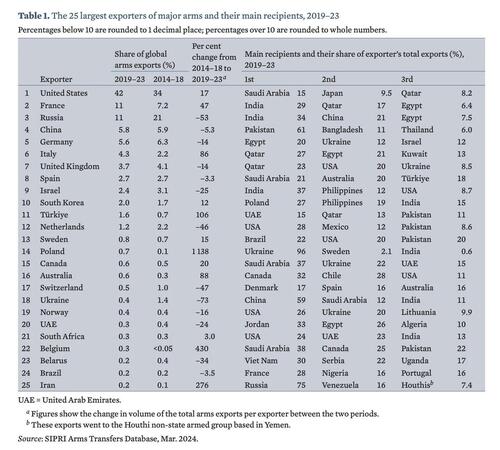
Among the “byzantine bureaucracy” that Project 2025 wants to cut is those bureaucratic impediments which prevent the US from exporting arms across the world at an acceptably rapid pace. The Heritage Foundation pinheads also want to eliminate the practice by which the State Department notifies Congress about such arms sales, decrying this already-meager oversight opportunity as a terrible “hinderance” (sp).
As far as the DOD’s “intelligence” assets, Miller advises that they more fulsomely “align collection and analysis with vital national interests (countering China and Russia).” Can someone explain what Democrats find so “existentially” horrifying about this? They support the same exact thing, and in fact often argue that Trump is insufficiently committed to countering Our Big Bad Enemies. If there’s an “existential threat” contained anywhere in this document, it’s the same one that Democrats are currently promoting at full-blast: a lurch into a hotter-than-Cold War with China and Russia. (Which was just bolstered once again at the Washington NATO Summit this week, having produced an official Declaration that came closer than ever before in designating China an official enemy, by accusing it of providing “material support” to Russia’s war effort in Ukraine.)
Miller wants to “increase the Army budget”; for the Navy, he wants to “build a fleet of more than 355 ships” as well as “produce key munitions at the maximum rate with significant capacity,” because the Navy must be urgently “prepared to expend large quantities of air-launched and sea-launched stealthy, precision, cruise missiles.” If any of this sincerely troubles hysterical Democrats, they would’ve been troubled by the budget-busting Defense expenditures that Biden has ushered in, building on the similarly budget-busting expenditures ushered in by the “dangerous” Trump. But of course they’re not troubled by any of this stuff.
As far as the Ukraine war, the author of the State Department portion of the tome, Kiron Skinner, a former Director of Policy Planning in Trump’s State Department, attempts to distill what she concludes to be the consensus “conservative viewpoint” with respect to Ukraine: “Continued US involvement must be fully paid for; limited to military aid (while European allies address Ukraine’s economic needs); and have a clearly defined national security strategy that does not risk American lives.”
This nicely mirrors what has indeed been the Congressional Republican consensus with respect to Ukraine policy under Biden, including among many self-proclaimed “MAGA” Republicans; it also tracks with the garbled and obfuscatory policy stance that’s been intermittently articulated by Trump.
Trump and the mainline GOP seldom ever object to the principle of funding and supplying the Ukrainian war effort. (After all, Trump is the one who started sending Ukraine lethal weaponry in the first place.) They simply call for that funding to be streamlined with a greater emphasis on core military expenditures, rather than the “economic aid” that Democrats are generally more keen to tack on. This was the essence of a House GOP policy brief that “MAGA Mike Johnson” (to use Trump’s preferred nickname for the Speaker) personally hand-delivered to the White House in late 2023, while the mammoth National Security Supplemental bill was being preliminarily negotiated — and which Trump himself eventually orchestrated the passage of. Another key prescription in that policy brief was that the US should “descope” its involvement in Ukraine to only that which is necessary for “enabling the killing of Russians on the front lines. That means providing the necessary weapon systems and tactics to win — not to tie.”
If you notice, this proclamation amounts to House Republicans (the group most acutely responsive to Trump’s political influence and dictates) arguing that the Biden Administration has been insufficiently aggressive in supplying Ukraine with weapons. The final War Funding Bill that Trump backed in April thus included a requirement for the Biden Administration to send Ukraine longer-range missile systems, which was then followed by Biden’s authorization for Ukraine to strike territorial Russia with US-provided materiel.
Project 2025 states that “European allies” must take center stage in “addressing Ukraine’s economic needs,” which is also already well underway, with the EU approving 50 billion euro in “economic” assistance several months ago. Hence, even the marginal, insignificant critiques of Ukraine policy in this document could become mostly irrelevant by the time Trump theoretically takes office.

So what exactly are Democrats and liberals blabbering about when they screech that Project 2025 is an “existential threat”? Insofar as it relates to the Ukrainian war effort, which they also fanatically support, the document merely reinforces and solidifies the pro-war bipartisan consensus. (As usual.) They should therefore be cheering the document, rather than screaming like banshees about it, but of course a rational policy analysis is not what Dems are aiming for with their present bluster. They just want a scary-sounding applause line for revving up anti-Trump voters by making them think Trump is getting ready to barrel into office with some crazed tyrannical plan, while omitting any mention that the “plan” is fully consistent with the foreign policy prescriptions they fervently support.
When it comes to what’s commonly referred to as the “Deep State” in MAGA parlance — aka, the “Intelligence Community” — Project 2025 contains virtually the opposite as what’s being suggested by hysterical libs. (Go figure). Fundamentally, the guidance calls for marginally re-organizing the Intelligence Services so as to empower them.
Trump loves to grouse that elements of the National Security State were irrationally against him in 2016-2018, and that’s true as far as it goes, with the Russiagate/Mueller fiasco being proof of these tawdry machinations. So it would make sense that Trump and the people in his orbit would want to impose various safeguards to prevent any future sabotage against Trump. But the idea that this means Trump would radically overhaul the “Intelligence Community” and put it in service of Putin and Kim Jong Un, or whatever other nonsense, is just entirely wrong. Simply read the text!
The whole point of these fearsome reforms with respect to the “Intelligence Community” is to enable “an incoming conservative President” to use all the “intelligence authorities” at his disposal to more “aggressively anticipate and thwart our adversaries, including Russia, Iran, North Korea, and especially China.” Is this what Democrats have in mind when they hyperventilate about Project 2025? Of course not, because the Biden Administration is doing essentially the same exact thing. As usual, however, recognizing the fundamental cross-party continuity in US foreign policy and “national security” serves no one’s short-term partisan interests, so they have to deceive the public about it for votes.
The document merely recommends mild bureaucratic reorganization, some of which it says has already been implemented by the Biden Administration — at the urging of the outgoing Trump Administration!
To help further the legislative intent behind IRTPA, DNI Ratcliffe advised during the transition of incoming Biden DNI Avril Haines that the DNI should be the only Cabinet-level intelligence official. While his recommendation was adopted and has corrected the previously allowed imbalance by making the DNI the only Cabinet official and head of the IC at the table, the ODNI’s effectiveness and direction leave much to be desired.
With regard to the CIA, Project 2025 decries the tendency of “risk aversion or political bureaucracy to delay execution of the President’s foreign policy goals.” It thus recommends the diminution of bureaucracy and placement of individuals in the agency who will more effectively harness the power of clandestine operations to fortify and expand American hegemony. Another huge shocker!
The “intelligence” section of the document further advises the renewal of FISA warrantless surveillance, declaring that “Section 702 should be understood as an essential tool in the fight against terrorism, malicious cyber actors, and Chinese espionage.” Which again nicely aligns with Trump’s position, so far as it can be ascertained, seeing as he backed MAGA Mike Johnson’s successful effort to renew FISA in April, on the understanding that they both wanted Trump to be the one wielding that power when it next comes up for reauthorization in two years.
It would also be fascinating to hear exactly what Biden boosters find so objectionable about the document’s exhortation for the next Administration to double down on “ensuring Israel has both the military means and the political support and flexibility to take what it deems to be appropriate measures to defend itself against the Iranian regime and its regional proxies Hamas, Hezbollah, and Palestinian Islamic Jihad.” Yeah, nothing like that going on at the moment.
So when the MSNBC crowd shrieks that Project 2025 is the terrifying roadmap for the next Trump Administration, they perhaps have it half right. There’s every reason to think the plan does in fact broadly represent DC conservative priorities for the next administration. But what the shriekers fail to convey is that this comfortably aligns with vaunted bipartisan consensus on critical issues. Many sections could easily have been pilfered from a Democratic think tank.
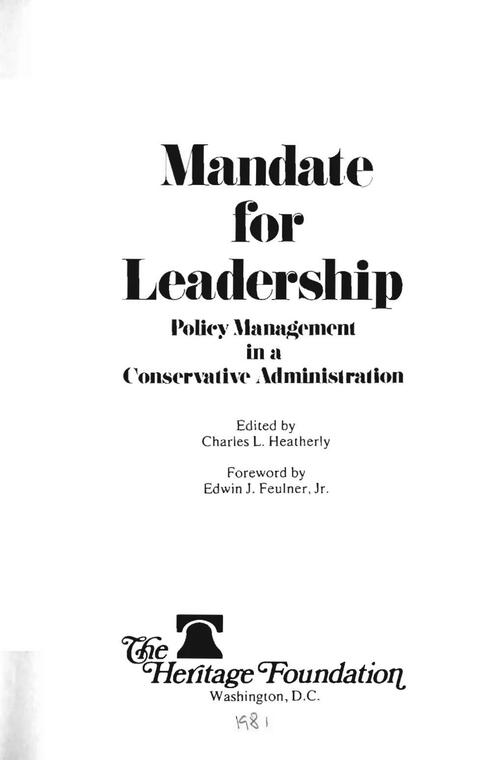
The 1981 version of the fearsome Think Tank manifesto
Yes, there’s a bunch more domestic policy stuff in Project 2025 that I haven’t focused on here. (I’ve only even highlighted a small percentage of the “national security” stuff.) But for the record, Ronald Reagan also ran on abolishing the Department of Education in 1980, back when he was also outsourcing his personnel and policy plans to the reviled Heritage Foundation. The abolition never happened. Whatever your views on this desirability of maintaining the existence of the Department of Education, the fact remains that this has been a bog-standard “Conservative Movement” aspiration for ages. So you might as well call the plan Project 1981 rather than Project 2025. To portray it as some sort of apocalyptic fascism unique to Trump is just totally ridiculous.
The 1981 version was compiled in 1979, similar to the advance compilation of the “2025” document, which was published in 2023. (The Reagan-era document is about equally as long and comprehensive, clocking in at at least 1077 pages, while the Trump-era document fizzles out at a paltry 920 pages). Comparable plans had also been drafted in the late 1990s in anticipation of the Conservative Movement returning to power after eight years of the Clinton Administration:
On August 20, 1999, the well-known American conservative think tanks, Heritage Foundation and The Project for a New American Century, together launched a policy statement calling for an end to the US’s “strategic ambiguity” policy on Taiwan, openly calling on the US government to “clearly announce that in case of an attack or blockade of Taiwan, the United States will go to defend Taiwan, including Kinmen and Matsu islands along the coast.” This statement has 23 people’s signatures, including Paul Wolfowitz, Lewis Libby (later served as Chief of Staff to the Vice President), Richard Perle (later was appointed as Chairman of the Defense Policy Board Advisory Committee, Rumsfeld’s main assistant), Richard Armitage (later served as Deputy Secretary of State).
“Project for a New American Century” might ring a bell as the classically “neoconservative” think tank that in 1998 wrote an infamous letter to Bill Clinton demanding regime change in Iraq. The letter was signed by a bevy of luminaries who’d later serve in the George W. Bush Administration, like Elliott Abrams and John Bolton, who also went on to serve in the… Trump Administration.
So yes, there’s plenty to be “alarmed” by in “Project 2025,” but none of it is particularly unique to Trump. Instead, it’s part and parcel of longstanding DC Conservatism, sometimes known as Con Inc., which will inevitably shape the personnel and policy framework of a forthcoming Trump Administration — just like it did with the previous Trump Administration. But of course that’s not the fear being stoked by anguished Dems, who are desperate to inspire the 10 millionth Mega Trump Panic in hopes of salvaging their current electoral prospects.
The Heritage Foundation used to love to tout that “the foundation had a great hour when Ronald Reagan was elected president and found waiting for him three volumes of Heritage material designed to help him chart the nation’s course in the right direction.” Undoubtedly future homages will be made to the amazing greatness of their influence under Trump, while befuddled Democrats wonder how “democracy” managed to remain in tact.




